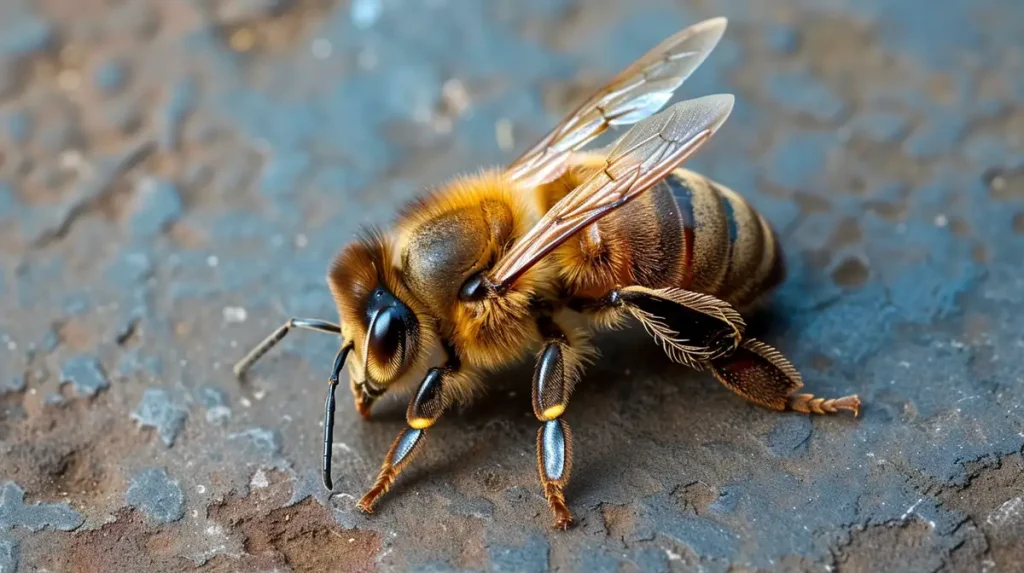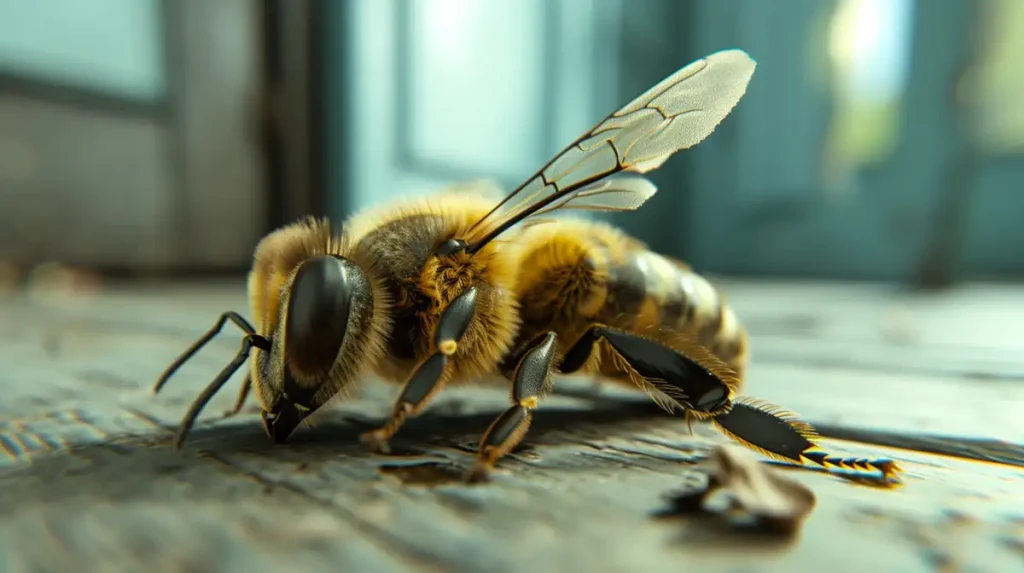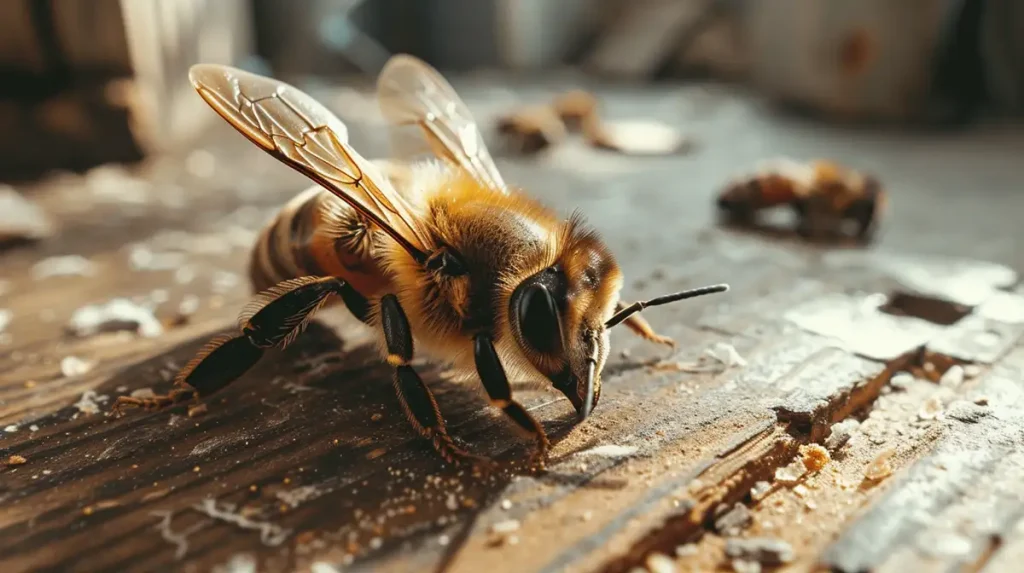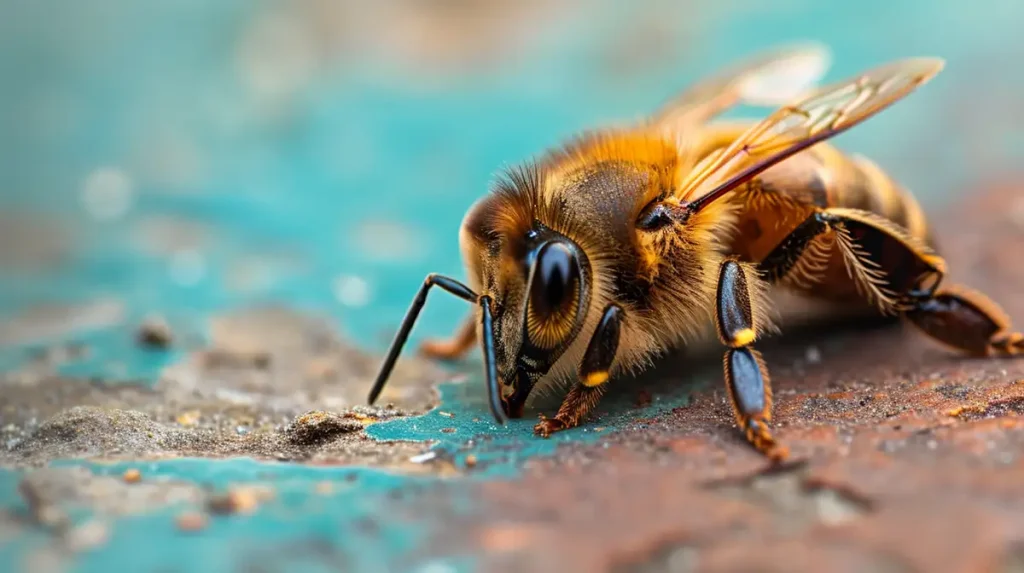Table of Contents
Bees, specifically honey bees, die after stinging due to the structure of their stinger. The stinger is barbed, and when a bee stings a mammalian skin, it gets lodged and cannot be pulled out. As the bee attempts to fly away, the stinger, along with part of its digestive tract, muscles, and nerves, is ripped from the bee’s body, causing fatal injury. This sacrificial mechanism ensures the delivery of venom to deter predators, but it results in the bee’s death.
In the below paragraphs, we will take a more detailed look at this topic.
One thing that many people are confused about is whether bees die after they sting. The confusion comes because some stinging insects such as wasps can sting multiple times whereas most bees will die after they sting. But why do bees die after stinging a person or animal?
Key Takeaways
- Not all bees die after stinging; it depends on the species.
- Honeybees, specifically female worker bees, have barbed stingers and die after stinging a mammal.
- Queen honeybees, bumblebees, and most solitary bees have smooth stingers and can sting multiple times without dying.
- Male bees, or drones, do not have stingers.
- Bees usually sting only when they feel threatened or if their colony is in danger.
- A bee’s stinger is a modified ovipositor, originally an egg-laying organ, that evolved into a defense mechanism.
- Stinging is a sacrificial act for honeybees, which release alarm pheromones when they sting, alerting other bees to potential danger.
- It is unlikely that bees possess the level of self-awareness required to understand the concept of death.
- Bees never sting for no reason; they do so to protect themselves or their hive.
- It is not recommended to run from angry bees, as sudden movements are perceived as a threat; instead, back away slowly without flailing your arms.
What Happens To Bees When They Sting?
When bees sting, there are specific consequences that take place for both the bee and the victim. Understanding these consequences can provide valuable insight into the bee’s biology and behavior as well as help us better appreciate these fascinating creatures.
Honey Bees and the Stinging Process
Honey bees, specifically female worker bees, are the ones equipped with a stinger. The stinger is actually a modified ovipositor (an egg-laying organ) that has evolved into a defense mechanism. When a honey bee stings, it injects a venomous substance called apitoxin into the victim. This venom causes localized pain, inflammation and, in some cases, an allergic reaction.
Unfortunately, for honey bees stinging is a sacrificial act. Their stinger is barbed, which means that once it penetrates the skin it becomes lodged and difficult to remove. As the bee attempts to fly away, its stinger, along with the venom sac and some internal organs, are torn from its body. This ultimately results in the bee’s death.
Other Types of Bees
It’s important to note that not all bees suffer the same fate when they sting. For instance, queen honey bees have smoother stingers and can sting multiple times without dying. Bumblebees and most solitary bees also possess smooth stingers, allowing them to sting repeatedly without causing self-harm. Additionally, male bees (or drones) do not have stingers at all.
Bee Behavior and Stinging
Bees are generally not aggressive creatures and will usually only sting if they feel threatened or if their colony is in danger. Therefore, it’s essential to treat bees with respect and avoid disturbing their hives. By understanding the consequences that bees face when they sting, we can appreciate the selflessness of these hardworking pollinators and do our best to protect and support them.

Do All Bees Die After Stinging?
Contrary to popular belief, not all bees die after stinging. The fate of a bee after it stings depends on its species. The bee family is quite diverse, with over 20,000 known species worldwide. However, when it comes to stinging behavior, we can focus on the three most common types: honeybees, bumblebees, and solitary bees.
Honeybees
Honeybees (Apis mellifera) are the ones most commonly associated with the “stinging and dying” phenomenon. When a honeybee stings a mammal, like a human, its barbed stinger becomes lodged in the skin. As the bee tries to fly away, it ends up leaving the stinger, along with its venom sac and part of its digestive tract, behind. This results in the honeybee’s death shortly thereafter. However, if a honeybee stings another insect, it might survive since its stinger won’t get stuck as easily.
Bumblebees
Bumblebees (Bombus spp.), on the other hand, have a smooth, non-barbed stinger. This means they can sting multiple times without suffering any fatal consequences. Bumblebees are usually less aggressive than honeybees, but they will sting if they feel threatened or if their nest is in danger.
Solitary Bees
Solitary bees make up the majority of bee species and, as their name suggests, they don’t live in large colonies like honeybees and bumblebees. Most solitary bees have a mild sting or no sting at all. Those that can sting, like the carpenter bee (Xylocopa spp.) or the leafcutter bee (Megachile spp.), have smooth stingers similar to bumblebees and can sting multiple times without dying.
- Carter, Anthony (Author)
- English (Publication Language)
- 194 Pages - 02/28/2024 (Publication Date) - Independently published (Publisher)
What Is The Purpose Of A Bee’s Stinger If It Dies After Using It?
The primary purpose of a bee’s stinger is to act as a self-defense mechanism to protect the bee and its colony from predators and threats. Although it might seem counterintuitive that a bee would die after using its stinger, this is a sacrificial act that has evolved to ensure the safety and survival of the colony as a whole.
Sacrifice for the Greater Good
The act of stinging releases pheromones that alert other bees in the colony to potential danger, prompting them to attack the threat en masse. The venom in the stinger contains a cocktail of toxins that can cause pain, swelling, and even allergic reactions in the target. The death of a single bee, in this case, serves as a powerful deterrent for predators, ultimately ensuring the safety of the entire colony.
Do Bees Know They Die When They Sting?
It’s a fascinating question to consider whether bees are aware of the consequences when they use their stingers.
Bee Behavior and Communication
Bees are social insects that live in colonies with a complex communication system. They use a variety of signals, such as pheromones and the waggle dance, to share information with their hive mates. When a honey bee stings, it releases an alarm pheromone that alerts other bees to the perceived threat, which can lead to more bees joining the defensive effort.
However, this doesn’t necessarily mean that bees are aware of their impending death when they sting. Bees are driven by instinct and their primary goal is to protect the colony. The act of stinging is their last resort to defend the hive, and their willingness to sacrifice themselves for the greater good of the colony is a testament to their strong survival instincts.
Are Bees Conscious of Their Mortality?
While bees possess remarkable communication skills and display impressive levels of organization, it’s unlikely that they possess the level of self-awareness required to understand the concept of death. They operate on instinct and their behaviors are primarily driven by the need to ensure the survival and success of the colony.

Do Bees Sting for No Reason?
A bee will never sting for no reason and will only do so to protect itself or its home. When bee’s sting humans or animals, it is because they believe they are under attack.
Once a bee stings, its stinger injects venom into the victim. The stinger that is left behind continues to pump toxins into the person or animal for several minutes. This is why it is important to remove a bee sting immediately, by whatever means possible.
A dying bee will also release a chemical or scent that alerts other bees to its demise. Bees in the surrounding area perceive this scent as danger and may then try to attack the predator. This is much more common when a threat is perceived around the hive.
Why Do Bees Chase You When You Run?
You may have heard that bees will chase you if you try to run away, and this is true in some instances. Bees are very protective of their home and will defend it at all costs. If they see you as a threat when you approach, they may begin to angrily buzz around your head. This is why many beekeepers will use smokers to calm the bees before they work in and around the hive.
If you happen upon a hive and the bees begin buzzing around your head and face, your first instinct may be to run. However, this is not recommended because it is a sudden movement and is perceived as a direct threat. Some bees, such as Africanized bees, will chase for up to a quarter-of-a-mile!
It is better to back away from angry bees slowly and without making any sudden movements. Do not flail your arms around, even if the bees are buzzing around you, as this will only aggravate them and possibly result in you being stung.

Why Do Bees Die When They Sting – Conclusion
Female honeybees have barbed stingers that remain behind in a person or animals’ skin after it stings. When the bee flies away, a part of its abdomen is ripped away, along with some of the digestive tract, nerves, and muscles. A bee is unable to survive such massive internal injuries and will die.
Bees only sting when they are under threat because they are aware that they will die afterwards. When they die, they release a scent that alerts other bees to danger. If the bees believe their home is under threat, they may attack.
Last update on 2024-04-17 / Affiliate links / Images from Amazon Product Advertising API


